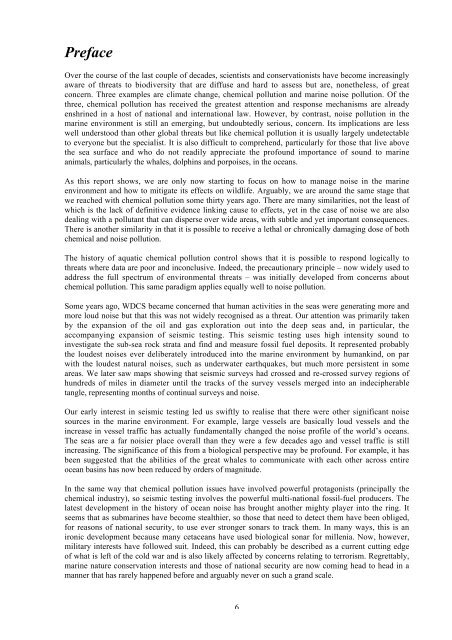Oceans of noise - Whale and Dolphin Conservation Society
Oceans of noise - Whale and Dolphin Conservation Society
Oceans of noise - Whale and Dolphin Conservation Society
Create successful ePaper yourself
Turn your PDF publications into a flip-book with our unique Google optimized e-Paper software.
Preface<br />
Over the course <strong>of</strong> the last couple <strong>of</strong> decades, scientists <strong>and</strong> conservationists have become increasingly<br />
aware <strong>of</strong> threats to biodiversity that are diffuse <strong>and</strong> hard to assess but are, nonetheless, <strong>of</strong> great<br />
concern. Three examples are climate change, chemical pollution <strong>and</strong> marine <strong>noise</strong> pollution. Of the<br />
three, chemical pollution has received the greatest attention <strong>and</strong> response mechanisms are already<br />
enshrined in a host <strong>of</strong> national <strong>and</strong> international law. However, by contrast, <strong>noise</strong> pollution in the<br />
marine environment is still an emerging, but undoubtedly serious, concern. Its implications are less<br />
well understood than other global threats but like chemical pollution it is usually largely undetectable<br />
to everyone but the specialist. It is also difficult to comprehend, particularly for those that live above<br />
the sea surface <strong>and</strong> who do not readily appreciate the pr<strong>of</strong>ound importance <strong>of</strong> sound to marine<br />
animals, particularly the whales, dolphins <strong>and</strong> porpoises, in the oceans.<br />
As this report shows, we are only now starting to focus on how to manage <strong>noise</strong> in the marine<br />
environment <strong>and</strong> how to mitigate its effects on wildlife. Arguably, we are around the same stage that<br />
we reached with chemical pollution some thirty years ago. There are many similarities, not the least <strong>of</strong><br />
which is the lack <strong>of</strong> definitive evidence linking cause to effects, yet in the case <strong>of</strong> <strong>noise</strong> we are also<br />
dealing with a pollutant that can disperse over wide areas, with subtle <strong>and</strong> yet important consequences.<br />
There is another similarity in that it is possible to receive a lethal or chronically damaging dose <strong>of</strong> both<br />
chemical <strong>and</strong> <strong>noise</strong> pollution.<br />
The history <strong>of</strong> aquatic chemical pollution control shows that it is possible to respond logically to<br />
threats where data are poor <strong>and</strong> inconclusive. Indeed, the precautionary principle – now widely used to<br />
address the full spectrum <strong>of</strong> environmental threats – was initially developed from concerns about<br />
chemical pollution. This same paradigm applies equally well to <strong>noise</strong> pollution.<br />
Some years ago, WDCS became concerned that human activities in the seas were generating more <strong>and</strong><br />
more loud <strong>noise</strong> but that this was not widely recognised as a threat. Our attention was primarily taken<br />
by the expansion <strong>of</strong> the oil <strong>and</strong> gas exploration out into the deep seas <strong>and</strong>, in particular, the<br />
accompanying expansion <strong>of</strong> seismic testing. This seismic testing uses high intensity sound to<br />
investigate the sub-sea rock strata <strong>and</strong> find <strong>and</strong> measure fossil fuel deposits. It represented probably<br />
the loudest <strong>noise</strong>s ever deliberately introduced into the marine environment by humankind, on par<br />
with the loudest natural <strong>noise</strong>s, such as underwater earthquakes, but much more persistent in some<br />
areas. We later saw maps showing that seismic surveys had crossed <strong>and</strong> re-crossed survey regions <strong>of</strong><br />
hundreds <strong>of</strong> miles in diameter until the tracks <strong>of</strong> the survey vessels merged into an indecipherable<br />
tangle, representing months <strong>of</strong> continual surveys <strong>and</strong> <strong>noise</strong>.<br />
Our early interest in seismic testing led us swiftly to realise that there were other significant <strong>noise</strong><br />
sources in the marine environment. For example, large vessels are basically loud vessels <strong>and</strong> the<br />
increase in vessel traffic has actually fundamentally changed the <strong>noise</strong> pr<strong>of</strong>ile <strong>of</strong> the world’s oceans.<br />
The seas are a far noisier place overall than they were a few decades ago <strong>and</strong> vessel traffic is still<br />
increasing. The significance <strong>of</strong> this from a biological perspective may be pr<strong>of</strong>ound. For example, it has<br />
been suggested that the abilities <strong>of</strong> the great whales to communicate with each other across entire<br />
ocean basins has now been reduced by orders <strong>of</strong> magnitude.<br />
In the same way that chemical pollution issues have involved powerful protagonists (principally the<br />
chemical industry), so seismic testing involves the powerful multi-national fossil-fuel producers. The<br />
latest development in the history <strong>of</strong> ocean <strong>noise</strong> has brought another mighty player into the ring. It<br />
seems that as submarines have become stealthier, so those that need to detect them have been obliged,<br />
for reasons <strong>of</strong> national security, to use ever stronger sonars to track them. In many ways, this is an<br />
ironic development because many cetaceans have used biological sonar for millenia. Now, however,<br />
military interests have followed suit. Indeed, this can probably be described as a current cutting edge<br />
<strong>of</strong> what is left <strong>of</strong> the cold war <strong>and</strong> is also likely affected by concerns relating to terrorism. Regrettably,<br />
marine nature conservation interests <strong>and</strong> those <strong>of</strong> national security are now coming head to head in a<br />
manner that has rarely happened before <strong>and</strong> arguably never on such a gr<strong>and</strong> scale.<br />
6

















